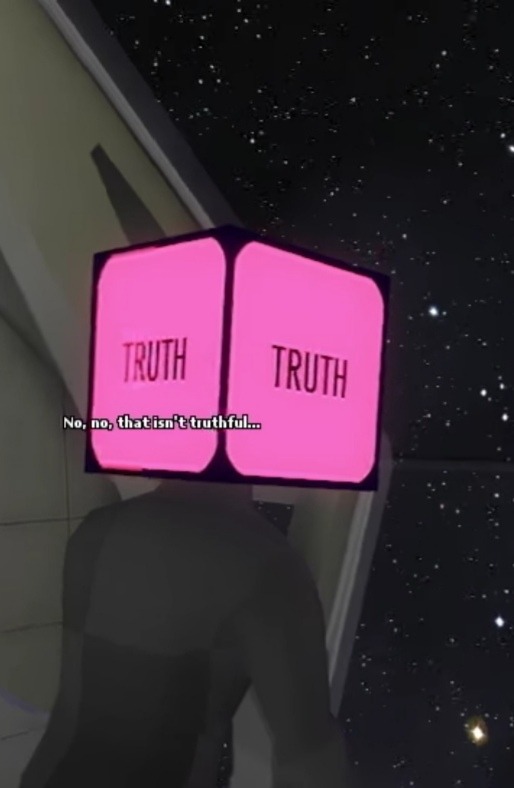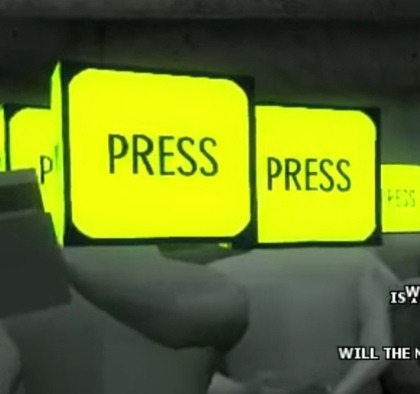Where your favorite blogs come alive
The Beginners Guide - Blog Posts
This is beautifully said dude.
Shina's TBG ramble time: Boxheads and the circles of themes
So I've been thinking about all the Boxheads and how there is an overall scheme, both to the words they use and to the colour palette

So, the first time they show up, there are two listen and speak sides. This is the first category of box heads -
1. VERBS.

These show up a few more times but mostly, they're all the most saturated coloured boxheads in the game. They're all also glowing,
Green is often said to be a colour of nature, creativity, hope, calmness but also, of immaturity, greed, possessiveness.
These Boxheads show up near the half of the game. Chapter 7, Down, features the first instance of these folks and they seem hopeful about getting out of the prison and with the way they talk, they do seem a bit childish when you tell them you don't know the exact way thst they could leave.
The next instance of the green head is in Chapter 10, House. Davey the character said that during that period of time Coda seemed the most happy. The character seems a bit shy with their thoughts but overall, there seems to be calmness and peace in that routine.
So, both instances of green show kinda that calm vibe from someone telling us to do a thing - either a house choir or answer their question but overall, I do feel calmness meaning works the best for these. These are games Coda made when he already met Davey and was pre-'depression'. They are bith commands and actions but even if you don't have a choice, you don't exactly feel forced to do anything.
Green will show up once again later in the game.

Yellow (tumblr doesn't have yellow, pls just pretend) often symbolises hope, intellect, but also deceit and faithlessness. It's also supposed to grab attention. Opposite to it is purple, to which Magenta can be seen as subcolour (or just colour close enough on the spectrum jshsu) . It can mean emotional balance but also can mean despair.
These beautifully fit with the theme of Chapter 11 Lecture. The student wants to listen to the professor/coach and feel better about themselves, get motivated to do anything. In the meantime, the teacher seems smart with everything they're saying until you get to see the other greyed out options they have. And due to the informality of coaching and one sided nature of it, 'talk' fits way more than 'speak', though that could be debated since speeches are typically also said to a crowd. But they're more often formal - and since we as a Player can control the coach, we can get very personal with all the little confessions of his mind.
As I said though, green will make a return. Not as a verb, however - but as an empty space, surrounded by the
2. ADJECTIVES
The previous category was quite consistent with he word class they used. The next two will mix a bit in one level but let's not get ahead of ourselves.
The theme of depression and isolations starts in Chapter 12, Theatre. This is the most unique Boxhead as each side has different words, beside one which is empty green.


Blue symbolises freedom, trust, confidence, reflection, honesty but also passiveness, coldness, depression. The narrator from this chapter wants to relive a moment with this possible idol of theirs. Each side seems to be a positively charged adjective (wise, successful, focused. happy) . However, instead of talking to them, we keep hearing comments of how we just don't act correctly. Mixing this with greens from earlier, the possessiveness for nostalgia of this exact moment, the childishness of the narrator throwing a tantrum when we don't even know the script and the bars at the end of the chapter all kinda show why Davey might have interpreted this as a shout for help.
3. NOUNS (and other shenanigans)
Chapter 13, Mobius.


There are different messages on these Boxheads - Blind, Captain, Research and Truth. All of these, expect for Blind can count as a noun. However, blind doesn't have to only be an adjective - it can also be a verb, together with Research.
Red can mean desire, confidence, determination but also danger, rage, impulsiveness. Pink has similar enough meanings to Magenta so I'll skip repeating myself.
While social anxiety and nostalgia were quite a strong theme in the prev chapter, this one, as Davey said himself is not as much of a denial like the last one, but acceptance of the state Coda seems to be in. Somehow, the obsession of creation that shows up as the Puzzle Door coming at us, the lammpost stands near us, just like the truth, witnessing the fall of a creator. The rage of not being able to feel passion anymore is stopped the moment we choose the response Truth wants from us. There is a desire hidden in there, a self reflection but it's not as strong as the previous Magenta usage.
You also can see an interesting phenomenon - the first characters you meet are full Blinds, so, adjectives, then you meet Captain and Research that show the first usage of noun and then you meet Truth.
It's as if there was a progressions... Haha what if the next ones would be also nouns,, nah that can't be the -
So the next Boxheads you meet are in Chapter 15, Machine.


We return to the Yellows but before that, we see a Guard who's the only case of White text. But, I'd also like to point that yellows were used in the beginning for the coach which was in the verbs group. But if you think about it - both guard and press can serve as both nouns and verbs.
Grey can mean neutrality, compromise, stability but also coldness, depression, predictability. Together with the Yellow, the cold attitude of the reporter who goes to the Machine, starts to give their own meaning to its silence, getting the press against it and causing destruction.
4. OK but... What's the point of all this?
It is rather interesting thst in the end, we returned to verbs and yellows. This is ofc just an oversimplification but let me show you the colour wheel based on the usage of colour for the Boxhead

We go full circle.
In TBG, repetition and reoccurring themes are constantly visible. Some sort of a prison, the puzzle games, even the lamppost but also, isolation, self doubts, fight as a creator. And this repetition shows through npcs, too. You could count Notes chap 8 as that too and revert first in the circle but overall, things seem to stay overall the same.
For the word class - we go from action to description to a role. Davey first describes what Coda used to do, then focuses a lot on telling us insights on how Coda was at the time of making certain games and then starts becoming not only a Friend but a Saviour. And Coda, from acting, sees he becomes an object to adore and talk about and then, to serve Davey a role of getting appreciation and acceptance for Coda's work. But in the end, Davey decides to publish game in the end. Even with the self reflection, even if he leaves us, the game still exists. And while Davey the character and the real Davey are diff people, Davey the char did say that he uploaded it.
The themes in this linear game keep on repeating, showing up, again and again, creating a closed off cycles. But neither Coda nor Davey the char are present in the end.
You, however, are.
Just like you are here, witnessing me doing a Davey with my interpretation on this jauahahau
Hey! Just wanted to let you know, I really love that art you made for the Beginner's Guide. I think it's pretty neat!
thank you very much !! im glad to hear you like it :-)


that crosshatching took me a good 10-15 minutes alone